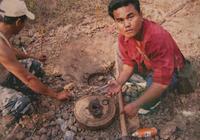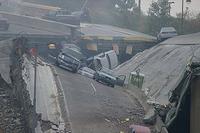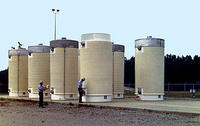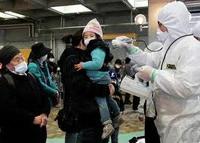-
Improving landmine detection – and air travel safety

It is estimated that there are about 110 million active landmines lurking underground in sixty-four countries across the globe; each year as many as 25,000 people, most of them civilians, are maimed or killed by landmines; the mines not only kill and maim, they can paralyze communities by limiting the use of land for farming and roads for trade; researchers offer a better way to detect landmines – a method which can also be used in airports to help thwart possible terrorist threats
-
-
New, affordable instant warnings of bridge collapse

The Federal Bureau of Transportation lists nearly 70,000 U.S. bridges as “structurally deficient,” requiring extra surveillance; in addition, more than 77,000 others are categorized as “obsolete” — exceeding their intended lifespan and carrying loads greater than they were designed to handle; researchers developed a new technology for monitoring these 150,000 aging U.S. highway bridges
-
-
Examination of Finnish lakes reveals radiation secrets
A new study casts doubt over the validity of models used to assess the impact of radiation on human health; an examination of the affects of radioactive fallout from the 1986 Chernobyl accident on two Finnish lakes sows that the transfer of the radioactive compounds is non-linear, and that the levels of radioactive compounds appear to be three times higher in fish-eating species (piscivores) than in non-fish-eating species
-
-
Radiation detection equipment installed in four Mexican ports
The Megaports Initiative is a U.S. Department of Energy program intended to enhance the ability of ports around the world to detect and interdict illicit shipments of special nuclear and other radioactive materials; Under the initiative, radiation detection gear and protocols were implemented in the Mexican ports of Manzanillo, Altamira, Lazaro Cardenas, and Veracruz, through which 92 percent of Mexico’s containerized cargo pass
-
-
Science group: storing spent nuclear fuel in dry casks significantly safer then wet pools storage

An NRC report on the lessons of the Fukushima disaster says that storing spent nuclear fuel in wet pools is “adequate” to protect the public; a science groups says there is a significantly safer way to store the 55,000 tons of radioactive waste currently stored by the 104 nuclear power plants operating in the United States: transferring the spent fuel to dry casks
-
-
Deadly E. coli strain decoded
The secret to the deadly 2011 E. coli outbreak in Germany has been decoded; the deadliest E. coli outbreak ever, which caused fifty-four deaths and sickened more than 3,800 people, was traced to a particularly virulent strain that researchers had never seen in an outbreak before
-
-
Resolving mystery odor alarms
In the post-9/11, security-conscious era, unidentified odor often cause the precautionary evacuation of buildings, airport terminals, and more; a New Jersey company offers an educational video on the problem of mystery odors – and offers odor identification services to help identify and resolve mystery odor complaints
-
-
New rapid diagnostic test for pathogens, contaminants developed
Using nanoscale materials, researchers have developed a single-step method rapidly and accurately to detect viruses, bacteria, and chemical contaminants; the method could be used to detect pathogens and contaminants in biological mixtures such as food, blood, saliva, and urine
-
-
Calculating the global health consequences of the Fukushima nuclear disaster

Radiation from Japan’s Fukushima Daiichi nuclear disaster may eventually cause approximately 130 deaths and 180 cases of cancer, mostly in Japan; researchers have calculated; the estimates have large uncertainty ranges, but contrast with previous claims that the radioactive release would likely cause no severe health effects
-
-
Northrop Grumman's biodetection solution completes field test
Northrop Grumman says its Next Generation Automated Detection System (NG-ADS) for homeland defense applications has successfully completed a field test and is ready for the program’s next phase
-
-
Space radiation detection technology to be used for homeland security
Common radioactive sources emit gamma rays while nuclear bomb material emits both gamma rays and neutrons; because neutrons and gamma rays are electrically neutral, it is difficult to ascertain properties such as the direction of origin or energy level of the radioactive source; University of New Hampshire scientists are re-engineering instruments originally built for detecting radiation in space for homeland security purposes
-
-
New international plan to tackle cyber crime, make Internet safer
A new international plan to tackle cyber crime has been launched; the new research roadmap has been developed by leading international cyber security researchers along with industry and government experts, and it aims to help make the Internet of tomorrow a safe and secure platform which is vital for global economic growth and societal development
-
-
Training the nuclear forensics experts of the future
Ten percent of the U.S. experts in nuclear and radiochemistry are at or nearing retirement age, according to a recent report from the National Academies of Science; meanwhile, not enough students are being trained to take their places; undergraduate summer programs in nuclear forensics and nuclear chemistry aim to replenish the ranks
-
-
New book confirms Israel behind killing of Iran nuclear scientists
A book to be published today offers details about, Israel’s campaign to take out Iranian nuclear scientists, a campaign which is part of the Israel’s broader effort to prevent Iran from acquiring nuclear weapons; the book also says that the cyber campaign against Iran’s nuclear program was an Israeli innovation, not an American one as recently reported; it was the brainchild of Israel’s military intelligence agency (AMAN) and Unit 8-200 — Israel’s equivalent of the eavesdropping, code-breaking National Security Agency (NSA) — and endorsed by the White House at Israel’s suggestion
-
-
Advanced IED detectors save lives

Almost 60 percent of all coalition forces wounded or killed in Afghanistan since the start of the war in 2001 have been due to IEDs; to complicate matters, insurgents in Afghanistan have been increasingly constructing IEDs to circumvent simple metal detectors; some IEDs contain rudimentary materials such as wooden boards, foam rubber, and plastic containers; the finished product contains very little metal making it difficult for a traditional metal detector to pick up
-
More headlines
The long view
Keeping the Lights on with Nuclear Waste: Radiochemistry Transforms Nuclear Waste into Strategic Materials
How UNLV radiochemistry is pioneering the future of energy in the Southwest by salvaging strategic materials from nuclear dumps –and making it safe.
Model Predicts Long-Term Effects of Nuclear Waste on Underground Disposal Systems
The simulations matched results from an underground lab experiment in Switzerland, suggesting modeling could be used to validate the safety of nuclear disposal sites.
